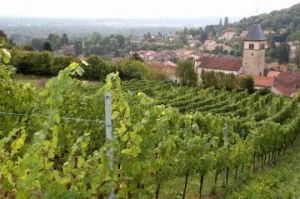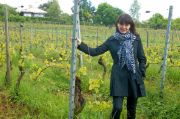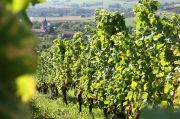 |

|
 © JC Kanny Moselle Tourisme © JC Kanny Moselle Tourisme

|
France’s most Northern appellation, the Moselle AOC offers excellent red and white wines but they are hard to find outside this region. A good reason to go there and visit the wineries that also produce sparkling wines.
[ Practical ]
Getting there
- By road
330 km from Paris on autoroutes A4 and A31.
- By train
TGV from Paris Est to Metz. The journey takes about 1 hour and 20 mn.
Lodging
Hôtel de la Cathédrale, in Metz
La Citadelle, in Metz
Ibis Centre, in Metz
Les Tuileries, in Fey
Au Relais du Château Mensberg, in Manderen
Restaurants
Le Magasin aux Vivres, in Metz
Les Tuileries, in Fey
La Vigne d’Adam, in Plapeville
Le Lion d’Or, in Ancy-sur-Moselle
La Vieille Porte, in Sierck-les-Bains
Le Château Fort, in Sierck-les-Bains.
Au Val Sierckois, in Montenach
Restaurant Olmi, in Petite-Hettange
Le Vic Tu Ailles, in Vic-sur-Seille
Getting around
It is necessary to have a car to visit the wineries.
Information
- Moselle Tourist Office
Tel : 0387215390
www.moselle-tourisme.com
No, Moselle wine does not necessarily mean Luxembourg or German wine. In France too, the vine is grown in the valley of the River Moselle and a AOC was introduced in late 2010. It is awarded to wines produced in the namesake department and made from specific grape varieties. Red made from Pinot Noir. Rosé made from Pinot Noir and Gamay, but the latter must not account for more than 30%. Mono-varietals made from Auxerrois, a white grape created near Metz in the early 20th century, Pinot gris or Muller-Thurgau, a grape variety originating from Switzerland which is not grown elsewhere in France.
 Limited production Limited production
Blended whites consisting of at least 50 percent of Auxerrois mixed with two or more other grape varieties chosen among Pinot Gris, Muller-Thurgau, Pinot Blanc, Meunier, Riesling and Gewurztraminer. Some wineries also produce red made from Gamay then sold under the "Vin de France " appellation.
Containing less residual sugars than those produced in neighbouring countries, these wines are excellent as evidenced by the award of the AOC but their prices remain reasonable : often under 10 € a bottle. In spite of this, they are little known outside the region because of limited production. Not more than 500 000 bottles per year, that is to say, less than some Bordeaux and Languedoc wineries. Highly fragmented, planted on south or southeast facing hillsides, the vineyards indeed cover only 64 hectares and are spread over three distinct regions. In addition, about ten hectares are used to produce sparkling wines made from Pinot Blanc and sold under the "Vin de France " appellation.
 Wine road Wine road
But local winemakers hope to get a “Crémant de Lorraine” AOC soon. However, to see so many vineyards in this department was still unexpected a few years ago since the planted surface had fallen from more than 6,000 ha in the 19th century to less than 10 ha in the early '80s.
So, wine estates are rare and small in size, ranging from less than a hectare to 12.5 ha. Nevertheless, they are easy to find thanks to the Wine Road recently created by the department’s tourist office. The majority are located in the Pays Messin, within 20 km of Metz, the region where the resurgence of viticulture in Moselle is most visible. Particularly in the Val de Metz, name given to the left bank of the Moselle, which is dotted with picturesque villages often dominated by fortified churches built between the 14th and 16th century where villagers could take refuge in case of danger. Let’s name Lorry-les-Metz, Norroy-le-Veneur, Sauny and Ancy -sur- Moselle.

 Marie-Geneviève Molozay © T. Joly Marie-Geneviève Molozay © T. Joly
|
 Château de Vaux Château de Vaux
In Scy -Chazelles, it is also possible to visit the house - museum of Robert Schumann, one of the founding fathers of the European Union, and not far from there, in Gravelotte, a museum dedicated to the Franco-Prussian war of 1870. Planted on limestone terraces, vines are often located above these villages where many ancient houses with vaulted cellars recall that the wine production was one of their main resources from the Roman era to the late 19th century.
Most famous winery of the region, the Château de Vaux is located in the village of the same name. It was founded in 2001 by Marie-Geneviève and Norbert Molozay , winemakers who have worked in Australia, in United States and in several French regions before deciding to settle in Moselle convinced that this land could give great wines. Managing their 12.5 hectares of vineyards biodynamically and organically, using some barrels made of Moselle oak to enhance typicity, they met the challenge.
 Export to the United States Export to the United States
Their red and white wines are now served in some of France’s best restaurants and exported in countries like United States and Great Britain. Do not miss to taste the cuvees named Pylae, Septentrion, Les Gryphées and Les Clos.
An encouraging sign for the appellation’s future, there are young winemakers as well. At Ancy -sur- Moselle, Eve Maurice has taken over from his father as head of the Domain des Béliers, planted new vineyards and created new cuvees getting praises from critics.
If you have time, go to the other bank, at Marieulles to visit the Oury -Schreiber winery whose wines, and especially sparkling ones, are among the best of the appellation. It was founded in 1991 by Pascal Oury, a winemaker native of Champagne, who was one of the leading architects of this revival. He died recently but his wife and his kids keep on producing top quality wines.

 © JC Kanny Moselle Tourisme © JC Kanny Moselle Tourisme
|
 Near Luxembourg and Germany Near Luxembourg and Germany
In the neighbouring village of Fey, the Sommy winery has an interesting history. It is indeed owned by Bernard Grandidier, a grain farmer who chose to diversify into wine growing. Successfully, and his wines repeatedly won awards in competitions.
The second production area is the Pays des Trois Frontières, 50 km north of Metz, so called because France, Luxembourg and Germany have common borders there. The vineyards extend over the hills bordering the Moselle around the villages of Haute-Contz, Sierck- les-Bains and Contz -les- Bains. In the latter, a museum set up in a former grower’s house presents ancient tools and evokes the long-standing winemaking tradition of the region. Nowadays, there are still 80 hectares of vines, but three quarters of them belong to Luxembourg and German winemakers who, after the harvest, take the grapes in their country. An incongruous historical legacy that is probably unique in Europe.

 © JC Kanny Moselle Tourisme © JC Kanny Moselle Tourisme
|
 Winemaker and distiller Winemaker and distiller
The remaining 20 hectares are divided among four French wineries, the largest one being Domaine du Stromberg run by Jean -Marie Leisen, who uses barrels made of Moselle oak too. He has the particularity of being a distiller as well and so produces excellent wines ( Pinot Noir, Muller -Thurgau , Auxerrois ) but also eaux-de-vie made from fermented fruit, especially mirabelle plum, a specialty of Lorraine, and even malt whiskey !!! If you want to have a panoramic view of the vineyards and the Stromberg hill, one of the best terroirs, go to the castle of the Dukes of Lorraine, a medieval building overlooking Sierck -les- Bains. The village itself is also worth a look as it boasts 16th and 17th century houses and remains of fortifications.
The third and smallest wine region of the department is further upstream on the Moselle, 50 km southeast of Metz, near Vic -sur- Seille. But there are only a few hectares of vines and a single producer, the Domaine Dietrich- Girardot. Although its Muller-Thurgau is a delightful wine, there is little to see for such a long detour. Unless you are an art lover because this small town hosts a museum dedicated to George de la Tour, one of the greatest French painters of the 17th century.
May 14, 2014
Thierry Joly 

|



